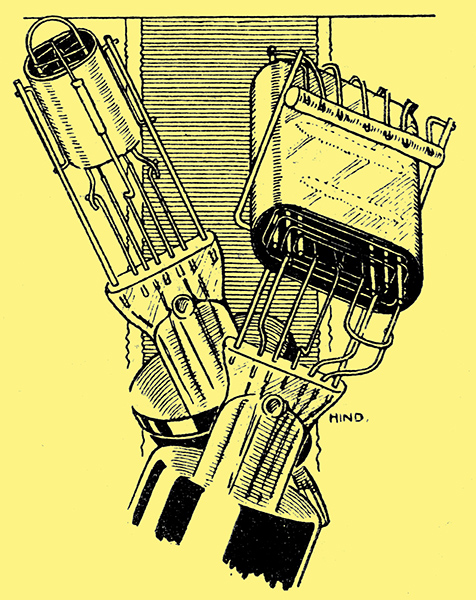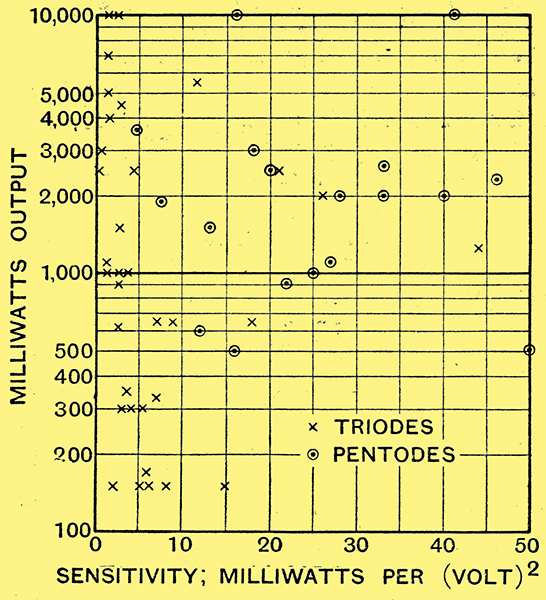|

Opinion is more or less divided upon the question of the choice between a triode or pentode valve in the output stage. In this article the author compares the two from the standpoints of sensitivity and efficiency.
Why are pentodes ever used? They are more complicated than triodes, and hence are more easily damaged; they are more difficult to harness to the loud speaker; there is a strong tendency for them to give poorer quality of reproduction; extra components are almost invariably required to prevent excessive shrillness; an extra HT tapping has often to be found; and important in these days they appear to cost a good deal more.
Since pentodes actually are used in vast quantities, it is obvious that they have something substantial to offer that overrides this impressive array of objections. They offer two advantages greater sensitivity and greater efficiency. As these words, and particularly efficiency, are commonly used in a loose and indefinite sense (e.g., ....bs Boot Polish is the most Efficient in the World), it is important to understand that here they are to be taken as exact scientific terms, so before going farther it will be as well to explain them.
The object of an output stage valve is to deliver a certain amount of power to the loud speaker; enough to produce as much sound as we want without distortion. For the valve to function, it is necessary to supply it, among other things, with a continuous flow of current to the anode (HT), and a varying or signal voltage to the grid.
Sensitivity
The sensitivity tell us how little signal voltage is necessary to make the valve furnish its quota of power, and the (efficiency indicates how little HT is required for the same purpose.
Sensitivity is measured in milliwatts (unit of power) per grid volt squared, written mW/V3. The grid voltage, which, let it be emphasised, is the signal voltage and not grid bias, is squared because the power is proportional to the square of the signal voltage. For example, if a valve which is adjusted to the most favourable working conditions delivers 1,000 milliwatts when the inter-valve transformer or other coupling connecting it to the previous valve is giving it 10 Volts, then the sensitivity is 1,000/102 = 10. It is substantially correct to go on to say that if the signal is 1 Volt the power output is 10 milliWatts. But it is not necessarily correct to suppose that if the signal is 20 volts the output will be 4,000 rnilliWatts, because that may exceed the limit of which the valve is capable. If we are offered the choice of two valves, each of which gives the required power, then the one with the greater sensitivity is the one that requires. the less voltage from the previous valve. So it may be possible by selecting it to work with a resistance coupling instead of a more expensive transformer, or even to cut, out a whole stage between it and the detector. On the other hand, we may not be at all pressed for signal volts, and then the more sensitive valve has little advantage.
Efficiency is expressed as a simple percentage because the HT power is also measured in milliWatts, so this is a very easy calculation. For example, a 500 milliWatt output valve requires 10 milliAmps at 200 Volts. The input is therefore 10 × 200 = 2,000 milliWatts, and the efficiency is 500 /2,000, or 25%. The importance we attach to efficiency depends on how much we have to pay for power; as battery power costs roughly one pound sterling for every penny charged for a similar helping from the mains, the battery user is likely to look at this matter through a very different pair of spectacles to that worn by the listener who plugs in. The time when the latter gives most thought to the problem is when he is contracting to pay for a new receiver, because the first cost goes up very steeply according to the demands made by the output valve.
Running Costs
If, therefore, the pentode is more efficient, that is, needs less power put into it to get the required amount out, it will cost less to run in a battery-driven set, and will make a mains-driven set less to buy. It may be urged against the latter claim that the pentode itself costs more. But examination of valve data, as published in Wireless World Valve Supplements, or The Wireless World Diary, brings to light the fact that a pentode costs little or no more than a triode capable of supplying the same output. In fact, in the larger sizes a pentode costs a good deal less. The 10,000 milliWatt pentode is priced at less than half the same maker's 10,000 milliWatt triode. For the usual 2,000 milliWatts a pentode is a shilling or two more than the corresponding triode. Of course, if the output is fixed at a very low figure like 150 milliWatts, the pentode looks rather expensive, because it is not made in sizes limited to such a small output.
Before we can assess the relative merits of the rival types we must know by how much the pentode excels the triode in its twin virtues of sensitivity and efficiency. The accompanying charts are intended to shed light on this question. The vertical scale in each of them is maximum power output, which we are using as a basis or comparison. It has been made a logarithmic scale merely to spread out the points evenly. The horizontal scales serve for percentage efficiency and mW/V2, respectively. The points indicate these two quantities for both triodes and pentodes listed by four makers whose products are comparable. The rather wide range of variation is perhaps due to the tact that some of these valves might well be placed on the retired list to make way for those more recently developed.
The Final Verdict

Fig. 1. - Chart to show the relative sensitivity of representative makes of triodes and pentodes.
Looking at Fig. 1, the sensitivity of triodes is seen to vary enormously from 0.3 to one stray hero on the 44 line. But, disregarding the prodigies, an average would be drawn at about 5. The pentodes also cover a wide field, but their average is more like 25. In other words, the average pentode gives about five times as much output as a triode for a given grid swing. But, as we are judging them on the basis of an equal output, in order to find out what the previous stage has to do, the same thing is better expressed by saying that the triode requires rather more than double the signal voltage applied to the grid to drive it at full throttle (actually √25/5 = 2.24 times as much if those averages are assumed. So the sensitivity of the pentode, which was acclaimed in the early days as equal to an extra stage of amplification, is actually of little account. There is seldom such a shortage of Volts from the detector that an intermediate stage is necessary even with a triode, and, as we have seen, an exceptional triode will compare with any pentode on this score.

Fig. 2. - Chart showing the relative efficiency of triodes and pentodes.
How about efficiency? The first glance at Fig. 2 finds a tendency for it to increase as the power rating of the valve increases. That is not at all surprising. It applies to most types of machines, and is one reason why lots of little electric power stations are being scrapped in favour of a few 'super' stations. So our conclusions depend to some extent on whether our interests lie in the 150 milliWatt class or the 10,000 milliWatt class or somewhere in between.
Fortunately for comparison, efficiency does not fluctuate so wildly as sensitivity, and there is not much difficulty in assigning an average of about 30% to the pentode. As the object is to compare the drain on the HT supply, the current taken by the auxiliary grid (which is often forgotten) is included in this calculation. The triode efficiency is more difficult to express in a single figure. In the lowest power classes, where there is no competition, it is round about 12%. Elsewhere the average may be put at 20% which means that from 800 milliWatts upwards the triodes require something like 50% more HT to handle the same amount of output as a pentode. That may signify very little or a great deal, according to circumstances. Though there are no pentodes limited to two or three hundred milliwatts, they can, of course, be operated with reduced HT for economical working in portable and other battery sets, and the efficiency is well maintained, whereas the competing triode falls oft rather badly, as we have seen. The advantage is then more like 100% in favour of the pentode. At the same time, not only is the efficiency maintained, but so also is the price, which likewise is about double that of the triode. It is now merely a matter of 'Consider your verdict, gentlemen', but, to prevent a deadlock, it will be necessary to have two jury-boxes, one for battery and one tor the mains
|